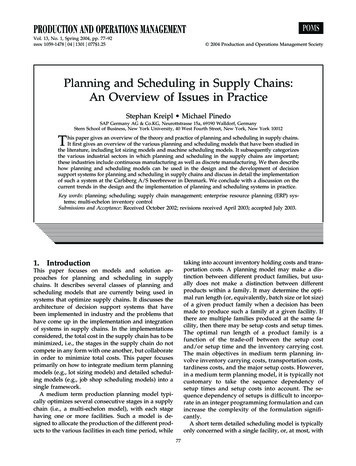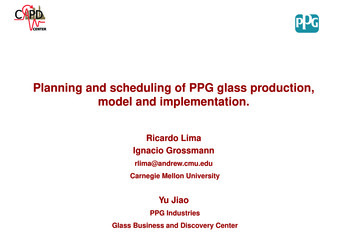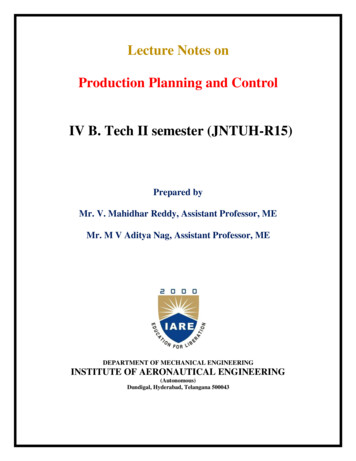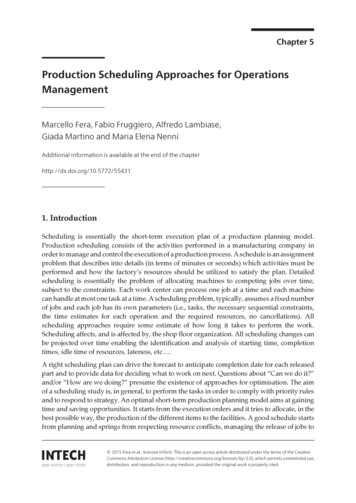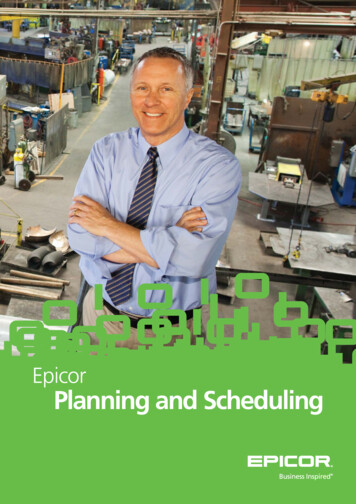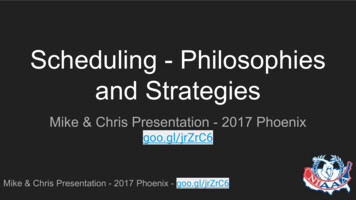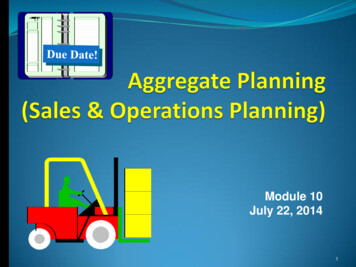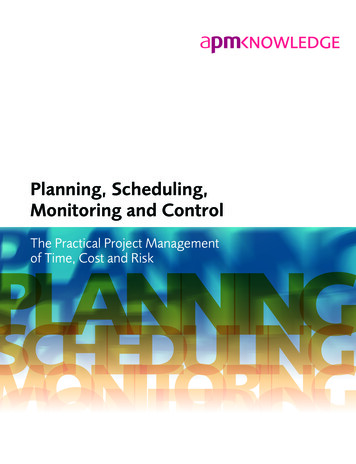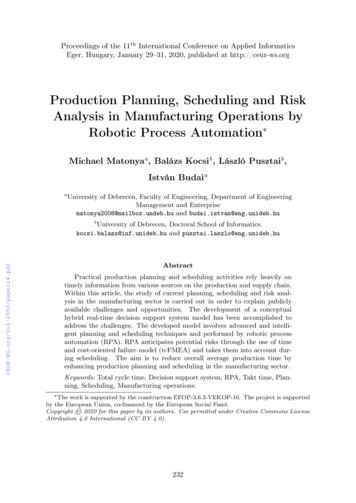
Transcription
Proceedings of the 11th International Conference on Applied InformaticsEger, Hungary, January 29–31, 2020, published at http://ceur-ws.orgProduction Planning, Scheduling and RiskAnalysis in Manufacturing Operations byRobotic Process Automation Michael Matonyaa , Balázs Kocsib , László Pusztaib ,István BudaiaaUniversity of Debrecen, Faculty of Engineering, Department of EngineeringManagement and Enterprisematonya2008@mailbox.undeb.hu and budai.istvan@eng.unideb.hubUniversity of Debrecen, Doctoral School of Informatics.kocsi.balazs@inf.unideb.hu and pusztai.laszlo@eng.unideb.huAbstractPractical production planning and scheduling activities rely heavily ontimely information from various sources on the production and supply chain.Within this article, the study of current planning, scheduling and risk analysis in the manufacturing sector is carried out in order to explain publiclyavailable challenges and opportunities. The development of a conceptualhybrid real-time decision support system model has been accomplished toaddress the challenges. The developed model involves advanced and intelligent planning and scheduling techniques and performed by robotic processautomation (RPA). RPA anticipates potential risks through the use of timeand cost-oriented failure model (tcFMEA) and takes them into account during scheduling. The aim is to reduce overall average production time byenhancing production planning and scheduling in the manufacturing sector.Keywords: Total cycle time, Decision support system, RPA, Takt time, Planning, Scheduling, Manufacturing operations. The work is supported by the construction EFOP-3.6.3-VEKOP-16. The project is supportedby the European Union, co-financed by the European Social Fund.Copyright 2020 for this paper by its authors. Use permitted under Creative Commons LicenseAttribution 4.0 International (CC BY 4.0).232
1. IntroductionThe gap between the theoretical and the practical reality of planning and schedulingdevelopment in the real world is growing. The gap is exacerbated by the increase ofcompound structures and other drawbacks in industry 4.0. Therefore most of thenewly developed technologies are being evaluated on a small scale and can even onlyend up being evaluated in the laboratory. Comprehensive production preparationrequires precise storage of raw materials, workstations, procedures, equipment andworkers involved in the supply chain.In the context of the manufacturing sector, preparation should also include theproduction of products most rationally and transparently possible and, during theplanning process, it should be possible to define the near-possible bottlenecks inthe supply chain and have the best possible means of completing the order on timewith titty cost margins.Production planning is followed by a production schedule which is the mostchallenging activity in any manufacturing sector, particularly one with a high lowvolume mix, which is difficult because production planning requires a highly combinatorial and complex decision-making process[8]. Efficient production planningallows the use of staff, equipment, machinery, etc. Accurate and instant valueadded information is highly anticipated in the production schedule for management to take decisions on time, especially in the digital manufacturing sector. Inthe industry 4.0 era setting, the fixing of several sensors in the production systemhas rapidly increased. Further real-time output information is stored in the datastorage network. The question is how much these timely data are going to supportthe production schedule on issues of timely delivery of tailored high-quality goodsand lower cost of production.1.1. Problem StatementThe idea is that there is a digital manufacturing cell that consists of more than fivemachines and has more than ten workers, from which there are several activitiesthat need to be carried out on the machines concerned. Project scheduling is a keyissue and the idea behind it is to simplify the existing production scheduling modelwith the help of robotic processing automation.The model developed involves the extraction of information from the ERPmethod, where KPI and output inputs are essential variables for the model. Theinformation obtained from ERP is collected by smart sensors which are mountedacross all machines and which are also capable of reading the attached work-pieceinformation which is to be processed in a given machine in the respective series.The goal is to build a conceptual hybrid real-time decision support systemmodel, Which includes sophisticated and intelligent planning and scheduling techniques and which is implemented through robotic process automation (RPA). TheRPA predicts possible risks through the use of failure mode and impact analysis(FMEA) and takes them into account during scheduling. The goal is to reduce the233
total average production time by improving production planning and scheduling inmanufacturing industries.2. Related Works2.1. Production planningProduction planning is a dynamic process requiring coordination between severalorganizational units of every organization. Planning includes what to do when tomake it, how much to make it, where to make it, the material required, and thetools needed.The overall efficiency of the production system depends on the efficient preparation and process design at the shop flow stage. There are three planning horizonsin production planning; strategic, intermediate and tactical, but these two horizonscover two areas of interaction with supplier relationships, costs and time markets.Considering the figure 1 below, the production planning starts from the strategiclevel as described in section 2.1 and planning is typically caused by real demand orexpected demand. Strategic planning is further broken down into incremental planning from quantitative planning, and comprehensive planning can be derived.Thepreparation of the material specifications is the next step after thorough preparation. The final and challenging stage of the model is planning, which is the focalpoint of discussion.Figure 1: A typical production Planning Approach [8]234
2.2. Production SchedulingScheduling is defined as the allocation of resources and the sequence of tasks for theproduction of goods and services. Production scheduling specifies the time eachjob starts and finishes on each machine. Often scheduling is characterized as an actof prioritizing or organizing activities to meet individual requirements, constraintsor objectives[15].The discovery of innovative production scheduling methods is becoming mandatory in today’s digitized output[6]. The Smart Scheduling layer mainly includesadvanced models and algorithms for drawing on data collected by sensors. Datadriven approaches and advanced decision-making architecture can be used for smartscheduling, for example, in order to achieve real-time, efficient scheduling and execution of distributed smart models using hierarchical integrated architecture[16].Real-time decision-making is the delivery of contextual and synchronized workflow information to any system anywhere at any time so that decisions can betaken. In the sense of production planning, smart sensors are necessary whenit comes to real-time decision-making. Most manufacturing plants continue touse different types of production Scheduling approaches to improve efficiency andminimize production costs[6, 9].Production planning in many manufacturing industries has been widely used inrecent years. It continues to be more prevalent in the modern era of cyber-physicalsystems or the digitalized manufacturing environment. Manufacturing of modernand innovative production scheduling methods is becoming mandatory in today’sdigital production[5, 6].The traditional production planning and scheduling methods do not deployrobotic process automation to anticipates potential risks through the use of timeand cost-oriented failure model (tcFMEA). The following section explains the mostcommon scheduling methods available.2.3. Production Scheduling TechniquesResearch on scheduling techniques has been published for many years. The mostcommonly used techniques include: Kanban[13], Dispatching Rule[4], branch andbound method[17], MRP, Analytical Methods or Exact Method comprising (NWorkers, One Machine, N Workers, Two Machines, N Jobs, Three Machines, TwoJobs, M Machines)[12, 3, 10], Mathematical Scheduling Optimization(Linear Programming Optimization) There is still a promising line of intensive research to comeup with productivity planning and scheduling that will characterize fast deliveryand optimized output costs[3, 10, 12].2.4. Robotic Process Automation in Industry 4.0Intelligent machines and raw materials are required to interact with each other inindustry 4.0 and to drive production processes cooperatively. Output should beversatile and individualized, in particular in mass production. The cooperation235
Figure 2: Production Scheduling techniques[Own Source]of computers, parts and raw materials would be highly dependent on the cyberphysical network of all items in development. Around the same time, sensors andactuators will be part of the Internet of Things. The cyber-physical system (CPS)is a collective network of digital elements governing physical entities. CPS arephysical and engineered systems whose operations are monitored, organized, managed and integrated by the computing and communication core[2] and defined byits three key characteristics; intelligence, connectivity and response to changes[11].The real-time decision support system is a core component of Industry 4.0. In orderto be successful, the decision support system also depends on the configuration ofthe robotic process automation (RPA).Robotic Process Automation is a technology framework that allows computersoftware to partially or completely automate human processes that are manual,repetitive and rule-based. RPA allows a organization the opportunity to modela business process that is definable, repeatable and rules-based, and to appoint a"robot" program to handle the execution of that process. It is estimated that 22%of information technology works will be replaced by robotic process automation inthe near future.[7]. Robotic is where machine mimics human actions, process is asequence of steps to perform a task and automation is executing any meaningfultask when done without any human interventions.RPA does not involve any invention of software/technology for automating.The same RPA tool can be used to automate various projects involving differenttechnologies and does not require any human intervention. In the market, there aremore than 12 companies that are involved in RPA but the top three companies areAutomate Anywhere Uipath and Blue Prism. Automate Anywhere is suggested tobe good for Forward Office(FOR) and Back Ward Office Robotic (BOR), Uipath236
is doing well in FOR and Blue Prism is good at (BOR).The main features of RPA are; Microsoft automation. Automating Microsoft Office applications may be the most used features of any RPA tool[1]. GUIAutomation. This is the process of simulating mouse and keyboard actions onwindows and controls Screen Scraping. This is the process of extracting text fromwebsites and win32 apps. Citrix Automation. Surface/ Citrix Automation isused because you cannot access the elements that make up virtual machines.2.5. Risk AnalysisFailure Mode and Effect Analysis (FMEA) is the most powerful and reliable methodfor analyzing risk analysis in general. However, time and cost-oriented failure model(tcFMEA) is used in section 3 because the application of FMEA is restricted andweak[14].The accuracy of the risk analysis depends very strongly on the correct use ofthe probability distributions to accurately express the complexity, randomness andvolatility of the problem. Program Evaluation and Review Technique (PERT), FourParameters Beta (Beta4) distributions, Triangle, Beta are the most appropriatedistributions that can represent the time and cost of production planning andscheduling in the manufacturing sector.2.6. Prerequisites of Production Planning and Scheduling inindustries 4.0In order for the production planning and scheduling in real-time decision supportsystem to work correctly, it highly depends on the two requirements which includes;The criteria for models: Include, the start date and finish of the job, theworkload time, the maximum completion time for each job, workload weight, thepreparation time for the work to be started, the number of job steps to be completed, the start time of the job to the respective machine.Prerequisites for the manufacturing environment: involve, Forecast market demand, real time technology (works, machines), commodity data, time-takeof each unit, case records, Internet of things (connectivity), captors and actuators,Mono-free output, monitoring systems, real-time inventory levels and accessibleERP systems. The development cycle needs the manufacturing environment.3. Conceptual Real-Time Decision Support Systemfor Scheduling Optimization ProcessFigure 3, shows the purely conceptual model of the Real-time decision supportsystem, which starts by receiving a job from the database (cloud emails) and isdocumented in the ERP. The data to be entered during registration includes JobID, customer names, due dates, processing steps, time taken, job values and other237
relevant information. The next step is to check the availability of all resources(machinery, labour and logistics equipment) for jobs. In case of Machinery resourcesavailability the flowing two factor are used;Machine availability factor(MAF) for job 𝑖 in machine 𝑗. MAF is a measure ofhow busy are the machines at respective time of scheduling. let 𝑆𝑖𝑗 Setup timeof job 𝑖 in machine 𝑗,𝑁 Number of set-ups ,like wise to 𝑄𝑖𝑗 Quantity of job 𝑖into machine 𝑗 , 𝐶𝑇𝑖𝑗 Cycle time of job 𝑖 in machine 𝑗. Where 𝐸𝑀 𝐶 EffectiveFigure 3: Conceptual Real time Decision Support System byRPA.[Own Source]238
machine capacity and 𝑁 𝑀 Number of machines(MAF) ︀𝐾𝐾 1𝑆𝑖𝑗 𝑁𝑖𝑗 𝑄𝑖𝑗 𝐶𝑇𝑖𝑗𝐸𝑀 𝐶 𝑁 𝑀Job Operational cost factor(JOCF) for job 𝑖 in machine 𝑗 is a ratio which isobtained by summation of all costs in a respective machine divided by total cost.𝑀 𝐶 Material movement cost,𝑆𝐶 Setup cost,𝑅𝐶 Run cost and 𝑇 𝐶 Totalcost of job 𝑖 and machine 𝑗 ︀𝑛𝑀 𝐶𝑖𝑗 𝑆𝐶𝑖𝑗 𝑅𝐶𝑖𝑗OCF 𝑛 1𝑇𝐶The most critical next step is the model itself, which must coordinate all thejobs associated with its operations in such a way as to reduce the total cycletime(span) of all the jobs that are the target of this project. After the arrangementand assignment of machine employees, risk factors shall be defined, classified, andtheir scenarios shall be calculated. The next step is to model the risk schedulingframework. If the scheduling tests are successful and correct, they will be processed;otherwise, the previous steps will have to be repeated. The RPA is also responsiblefor sharing information in real-time computers and handsets during the executionof operations. Job is registered and stored at any time in the cloud. Both feedbackand future decisions can be taken based on real-time data obtained and shared byRPA.4. SummariesThrough this paper, the study of current planning, scheduling, and risk analysis inmanufacturing activities have been carried out in order to highlight the challengesand opportunities available to the public. The development of a strictly conceptualhybrid real-time decision support system model involving sophisticated and intelligent planning and scheduling techniques and applied robotic process automation(RPA) has been accomplished in order to address the challenges.RPA forecastspotential risks through the use of time and cost-oriented failure model (tcFMEA)and takes them into account during preparation.The goal is to increase the total average production time by enhancing production planning and scheduling in the manufacturing sector.Qualitative data areobtained from literature reviews of different academic sources (newspapers, journaljournals, lectures, books and other online platforms) along with intuitive thought.A list of twenty-six preparation approaches is read in the literature and, separately,more than seventeen manufacturing criteria are identified, and 11 criteria are subsequently identified. Then more than 17 model requirements are described andcustomized to only 17 and, finally, conceptual model steps are created.A list of scheduling options has been compared. The design and productionrequirements relevant to the selection of the best scheduling program by the AHP239
analysis have been put in place. Furthermore, the computational model is developed, as shown in 3. To conduct the job accurately and on time in the company, itrequires hard-working workers and the appropriate information in the right periodat the right place.5. Future researchThe future study will involve an analytical, hierarchical process analysis of scheduling methods. The best selected method will be advanced into industrial practicalcase study.References[1] Asatiani, A., and Penttinen, E. Turning robotic process automation into commercial success–case opuscapita. Journal of Information Technology Teaching Cases6, 2 (2016), 67–74.[2] Gregori, F., Papetti, A., Pandolfi, M., Peruzzini, M., and Germani, M.Digital manufacturing systems: A framework to improve social sustainability of aproduction site, 2017 2017. ID: 282173.[3] Grosch, B., Weitzel, T., Panten, N., and Abele, E. A metaheuristic forenergy adaptive production scheduling with multiple energy carriers and its implementation in a real production system, 2019 2019. ID: 282173.[4] Hübl, A., Jodlbauer, H., and Altendorfer, K. Influence of dispatching ruleson average production lead time for multi-stage production systems. InternationalJournal of Production Economics 144, 2 (2013), 479–484.[5] Jain, A. K., and Elmaraghy, H. A. Production scheduling/rescheduling in flexible manufacturing. International Journal of Production Research 35, 1 (01/01 1997),281–309. doi: 10.1080/002075497196082.[6] Katragjini, K., Vallada, E., and Ruiz, R. Flow shop rescheduling under different types of disruption. International Journal of Production Research 51, 3 (02/012013), 780–797. doi: 10.1080/00207543.2012.666856.[7] Kirchmer, M. Robotic process automation-pragmatic solution or dangerous illusion. BTOES Insights, June (2017).[8] Kopanos, G. M., and Puigjaner, L. Solving Large-Scale Production Schedulingand Planning in the Process Industries. Springer, 2019.[9] Metaxiotis, K. S., Psarras, J. E., and Ergazakis, K. A. Production scheduling in erp systems: an ai-based approach to face the gap. Business Process Management Journal 9, 2 (2003), 221–247.[10] Mohan, J., Lanka, K., and Rao, A. N. A review of dynamic job shop schedulingtechniques, 2019 2019. ID: 306234.[11] Monostori, L., Kádár, B., Bauernhansl, T., Kondoh, S., Kumara, S.,Reinhart, G., Sauer, O., Schuh, G., Sihn, W., and Ueda, K. Cyber-physicalsystems in manufacturing, 2016 2016. ID: 273597.240
[12] Nowicki, E., and Smutnicki, C. New results in the worst-case analysis for flowshop scheduling, 21 September 1993 1993. ID: 271602.[13] Ohiomah, I., and Aigbavboa, C. Lean manufacturing: A case study with kanbansystem implementation in small and medium enterprise manufacturing companies innigeria. In 2017-Sustainable Industrial Processing Summit (2017), vol. 7, Flogen StarOutreach, pp. 190–195.[14] Osama ABUSALEM, N. B., and KOCSI, B. Implementing quantitative techniques to improve decision making in construction projects: A case study. An International Journal for Engineering and Information Sciences 14, 3 (2019), 223–234.[15] Sule, D. R. Production planning and industrial scheduling: examples, case studiesand applications. CRC press, 2007.[16] Zhong, R. Y., Xu, X., Klotz, E., and Newman, S. T. Intelligent manufacturingin the context of industry 4.0: A review, October 2017 2017. ID: 314095.[17] Žilinskas, J. Branch and bound with simplicial partitions for global optimization.Mathematical Modelling and Analysis 13, 1 (2008), 145–159.241
Production Planning, Scheduling and Risk Analysis in Manufacturing Operations by Robotic Process Automation * Michael Matonya a, Balázs Kocsi b, László Pusztai b, István Budai a a Univer
